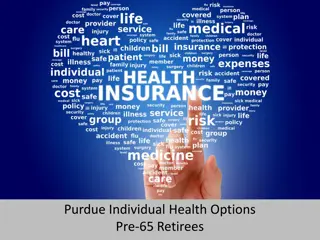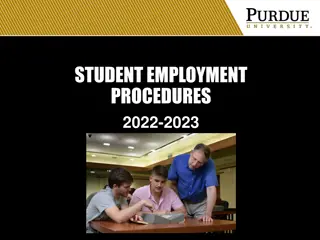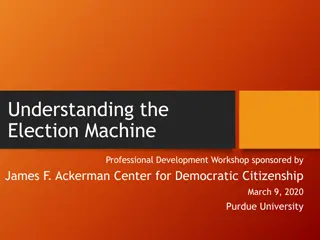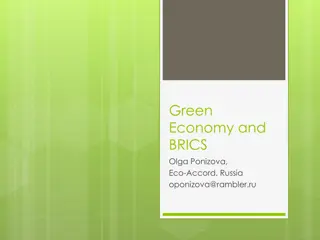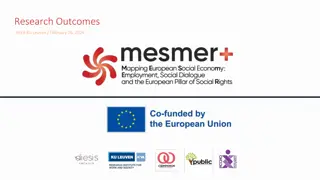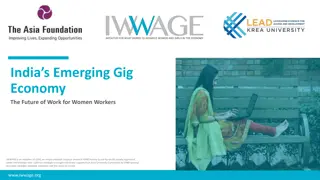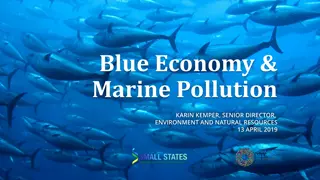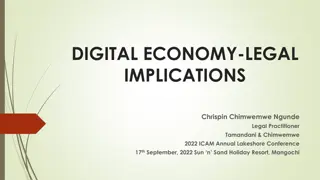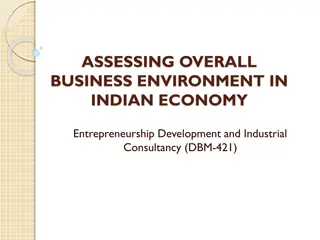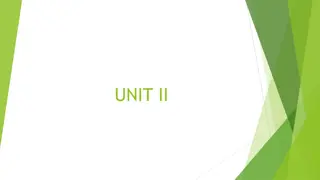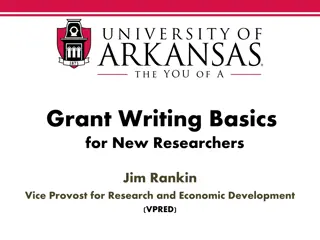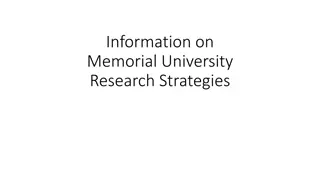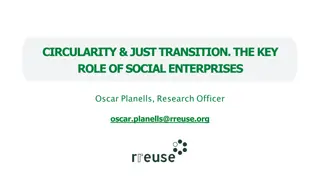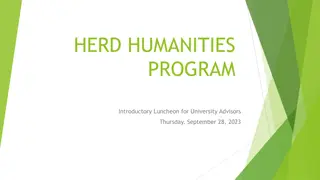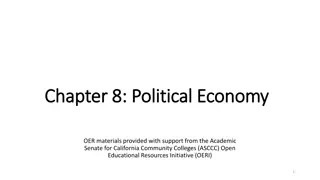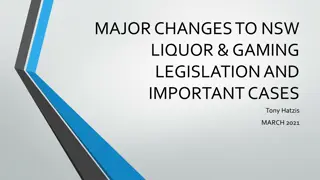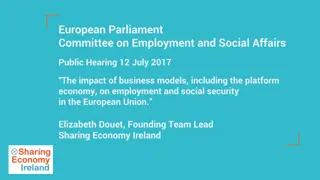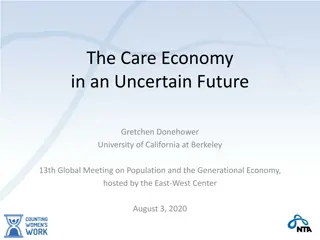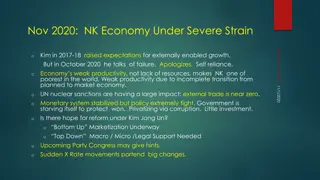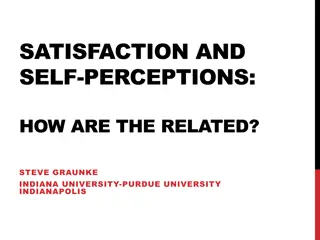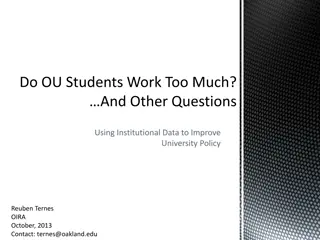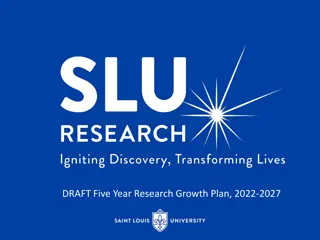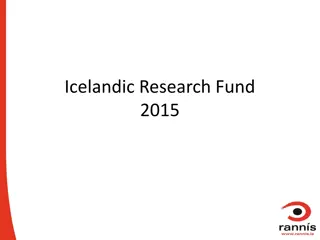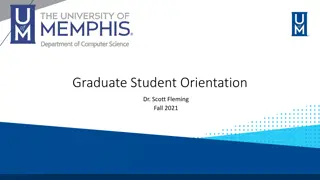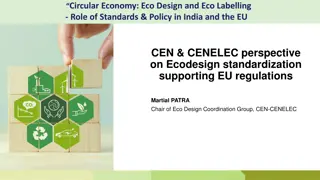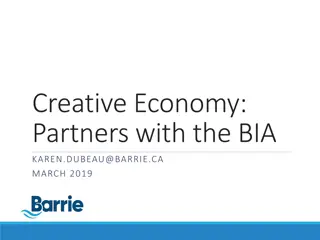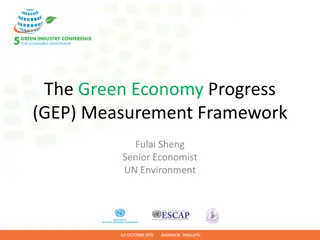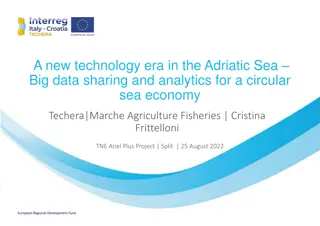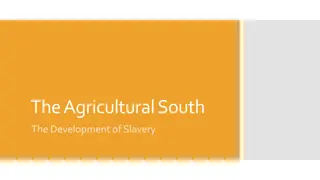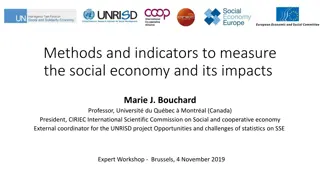The Impact of Purdue University on Research, Education, and Economy
Purdue University, led by researcher Bharat Bhargava, is contributing to the Department of Defense in the field of Artificial Intelligence. Amid COVID-19, the university is exploring novel AI systems through the SAIL-ON program. Additionally, Purdue's financial aid analysis and economic impact on Indiana highlight its crucial role in local and state economies. The university's revenue sources and risk mitigation strategies further exemplify its strategic approach to sustainability and growth.
Download Presentation

Please find below an Image/Link to download the presentation.
The content on the website is provided AS IS for your information and personal use only. It may not be sold, licensed, or shared on other websites without obtaining consent from the author. Download presentation by click this link. If you encounter any issues during the download, it is possible that the publisher has removed the file from their server.
E N D
Presentation Transcript
Covid and AI/ML/DS Bharat Bhargava Purdue University
Bhargava Purdue research Contributing to Department of Defense on The Science of Artificial Intelligence and Learning for Open-world Novelty (SAIL-ON) COVID is new novelty Science of Artificial Intelligence and Learning for Open-world Novelty (SAIL-ON) by Ted Senator, Darpa project manager The Science of Artificial Intelligence and Learning for Open-world Novelty (SAIL- ON) program intends to research and develop the underlying scientific principles, general engineering techniques, and algorithms needed to create AI systems that act appropriately and effectively in novel situations that occur in open worlds. The program s goals are to develop scientific principles to quantify and characterize novelty in open-world domains, create AI systems that react to novelty in those domains, and demonstrate and evaluate these systems in a selected DoD domain.
Purdue and COVID in fall semester Cost benefit analysis for opening Purdue in 2020-2021 Approximately 46.0% of new students receive some form of financial aid, the majority of which is scholarships and grants. 44551 students in 2019 I do not have much data. I believe 60% of our students have some kind of financial help and they can use it unless they enroll. So Purdue can get those easily. International students (10,000, 22%) want to come at any cost if they get the visa ( 50% grad students, 4400), 34.5 percent are out-of-state students I would think about 25,000 students are guaranteed. Purdue needs to work on the rest to get them pay fees. Purdue in-state tuition and fees are $9,992; out-of-state tuition and fees are $28,794
Impact of Purdue on Local Economy Purdue s economic impact in Indiana totals more than $2.1 billion According to the latest briefing by the Office of Institutional Research, Assessment and Effectiveness (OIRAE), Purdue s role as an employer and educator translated to 22 percent of all economic activity in the Greater Lafayette Area in fiscal year 2016.
Purdue University Purdue University Revenue by Category for FY Revenue by Category for FY 2019 2019 Tuition and Fees, Net, 40% State Appropriations, Noncapital, 14% Contracts and Grants, 14% Auxiliary Enterprises, Net, 8% Investment Income, 6% Gift, Noncapital, 4% Other, 14%
Risk factors and Mitigation Risk to funds from Donations, State Funds, Auxiliary services such as conferences, food sales, housing income Tuition The dangers to most college students from COVID-19 are extremely small. Why seriously compromise their education at this critical stage in their lives? Interfering with that socialization process may be desirable for health reasons, but we should use a cost- benefit approach, and I agree with President Daniels that the costs to most students from leading a fairly traditional campus life with direct human interaction is low, but the benefits are great. Mitigation solutions DS to identify and target possible donors and corporate partners Provide transportation to Indians resident students from close by counties so as not to lose them and reserve space for out of state and internationals in dormatories Hold classes outdoors in football stadium, basketball stadium, lawn, parks ( took classes in tents in India)
Food Safety research at Purdue New Purdue/Microsoft collaboration calculates agricultural product supply risk due to COVID-19 worker illnesses https://ag.purdue.edu/agecon/Pages/FoodandAgVulnerabilityIndex.aspx The Department of Agricultural Economics at Purdue University, in collaboration with Microsoft, has created the Purdue Food and Agricultural Vulnerability Index online dashboard to quantify the potential risk to the supply of agricultural products as a result of COVID-19 farm and agricultural worker illnesses. https://www.purdue.edu/newsroom/releases/2020/Q2/new- purduemicrosoft-collaboration-calculates-agricultural-product-supply-risk- due-to-covid-19-worker-illnesses.html
Vulnerability-RISK based on affected farmers- crops-animals https://purdue.ag/foodagvulnerabilityindex Built on top of Microsoft Azure and Power BI platforms, to quantify the potential risk to the supply of agricultural products as a result of farm and agricultural worker illnesses from COVID19. Vulnerability of the supply of an agricultural commodity to risks such as COVID-19 depend on the number of farmers and agricultural workers affected, the location of affected workers, the crops and animals that are grown in the most impacted regions, and the degree to which production is concentrated in a particular geographic region. By combining data on the number of COVID cases in each U.S. county with the county s total population, U.S. Department of Agriculture data on the number of farmers and hired farm workers in each county, and data on agricultural production of each county, and estimate of the share of agricultural production at risk can be computed.
Professor Jayson Lusk at Purdue and Raveer Chandra at Microsoft One of the things we ve learned over the past few weeks is how important it is to know where our food comes from and to be able to identify and pin point potential problem spots. This tool was designed to help us detect if and when a problem emerges, said Jayson L. Lusk, distinguished professor and department head of agricultural economics at Purdue and collaborator on the index. https://ag.purdue.edu/agecon/Pages/profile.aspx?strAlias=jlusk Ranveer Chandra, chief scientist at Microsoft Azure Global and lead collaborator on the project, said, Digital tools can help alleviate some of stresses we are currently facing in the food sector. We are collaborating with Purdue University to interpret data from different sources, and from multiple points in the supply chain, to add more visibility and identify potential risks to our food system.
Covid and MIT Rationing Social Contact During the COVID-19 Pandemic: Transmission Risk and Social Benefits of US Locations Read the paper How to reopen the economy during the coronavirus pandemic? A new study looking at the risks and benefits of different types of locations offers a guide for policymakers. https://mitsloan.mit.edu/ideas-made-to-matter/what-should-reopen-first-data-shows-way https://ssrn.com/abstract=3579678 The working paper from MIT Initiative on the Digital Economy researchers Seth Benzell, Avinash Collis, and Christos Nicolaides uses a cost-benefit analysis to rank each of 26 locations in terms of the tradeoff between relative risk of infection and importance to consumers and the economy. The researchers found banks, grocery stores, general merchandise stores like Walmart, and colleges and universities should face overall lighter restrictions and reopen earlier, while gyms, cafes, and liquor, tobacco, and sporting goods stores should face tighter restrictions and open later.
Risk and Benefit parameters The cumulative transmission risk of a location is based on four measures of social contact, starting with number of visits and number of unique visito person-hours the amount of time people spend there of visits during crowding of more than one visitor for every 113 square feet, or a six-foot radius circle person-hours of visits during crowding of more than one visitor for every 215 square feet, the German guideline of one person for every 20 square meters. visits by individuals 65 and older, the amount of distance travelled to a location, and the share of jobs at a location that require close physical proximity to perform. More COVID-19 research from MIT Sloan
MIT research on COVID http://news.mit.edu/2020/saxe-lab-examines-social-impact-covid-19- 0421 Examining the social impact of Covid-19: Survey from the Saxe Lab aims to measure the toll of social isolation during the Covid-19 pandemic by Julie Pryor | McGovern Institute for Brain Research A survey to measure how the social behavior of MIT students, postdocs, and staff is changing over the course of the pandemic. Survey questions were designed to measure loneliness and other aspects of mental health.
Columbia and COVID A new analysis finds social distancing has been very effective in slowing the spread of COVID-19 and that thousands of lives could have been saved if the policies began earlier. The U.S. could have prevented roughly 36,000 deaths from COVID-19 if broad social distancing measures had been put in place just one week earlier in March, according to an analysis from Columbia University. Underlining the importance of aggressively responding to the coronavirus, the study found the U.S. could have avoided at least 700,000 fewer infections if actions that began on March 15 had actually started on March 8.
EPFL and contact tracing EPFL researchers put proximity tracing app to the test https://actu.epfl.ch/news/epfl-researchers-put-proximity-tracing-app- to-th-2/ EPFL computer scientists have been testing and refining the smartphone-based system developed by the international Decentralized Privacy-Preserving Proximity Tracing project (DP3T), with the help of the Swiss Army. Their goal: to optimize the app s ability to alert users after they ve been in contact with someone contagious with COVID-19, while building trust around the open system.
EPFL and Contact Tracing-Payer DP3T is an approach to decentralized, privacy-preserving contact tracing that aims to provide a digital means for humans to stop the spread of the novel coronavirus. The project was initially launched by researchers from EPFL and ETH Zurich, and is now being developed in collaboration with a number of other leading European institutions, as well as software developers Ubique and PocketCampus. Mathias Payer, head of the HexHive lab in EPFL s School of Computer and Communication Sciences (IC), explains that recent tests carried out on the EPFL campus were designed to compare the DP3T system s proximity measurements with data on Swiss Army soldiers physical positions. The soldiers were asked to mimic daily activities like shopping or sitting on a train, while their positions were captured and analyzed using specialized cameras from EPFL'S Computer Vision Laboratory (CVLab), led by Pascal Fua. On April 30th, just a week after the EPFL tests, Payer led a 24-hour field test at a military facility with about 100 soldiers. This time, the soldiers performed routine tasks while the app ran on their phones, and took note of each time they came into contact defined as less than two meters for more than five minutes with another person. We wanted to establish a baseline for how people actually act in different situations, Payer explains. He adds that an additional challenge was to calibrate the system to work regardless of whether a user s smartphone was in their hand, in their backpack, etc. We tested different parameters, such as signal strength and frequency, to ensure that the system generates good information without too many false positives, and without draining your phone battery. This signaling system is at the core of the DP3T technology: it uses Bluetooth signals to continuously broadcast random and impossible-to-guess strings of characters between smartphones. All sent signals, as well as those received from nearby devices, are stored on users phones for a maximum of 14 days. If a user is diagnosed with COVID-19, their unique character sequences will be added to a hospital list, which other users phones will check regularly to see if they recognize any of them. If a match is found that indicates a user was near a COVID-19 patient long enough to risk infection, the app will display an alert, asking the user to self-isolate and enabling him or her to get tested as soon as possible.
Privacy Issues Privacy by design The idea of using smartphones for proximity tracing has raised concerns over data privacy, as critics argue that such a system could create new opportunities for personal information to be abused, even after the pandemic eases. But the DP3T team is working to ensure that even if a hacker could get their hands on the signal data which will be stored only on users smartphones, rather than a centralized server it would be useless to them. This is privacy by design: we wanted to create a system that respects the need of citizens, which is not just to stop the coronavirus, but also to preserve freedom. So, we are building an app that cannot be used for anything other than contact tracing it cannot be used to know location, identities, or activities, says Carmela Troncoso, head of EPFL's Security and Privacy Engineering Lab (SPRING). She adds that the system is also designed to dismantle itself organically as soon as the app is uninstalled from a smartphone, which will delete all stored signal data, thus placing control of the system in the hands of users.
Plans for Future Looking ahead As the parameter tests of the DP3T system are completed, all results will be published online to encourage continuous feedback and refinement. A beta version of the DP3T app is anticipated by mid-May; however, the researchers emphasize that the rollout of the app for use by citizens is ultimately within the purview of the Swiss government. In the meantime, the DP3T team is working to ensure that the system will be ready to welcome a forthcoming application program interface (API) from Apple and Google, which is still under development. This is all happening in parallel. We have an app that works using our protocol, and that is compatible with Apple and Google s protocol. As soon as that protocol is available, we will switch to it, as it will simplify integration with iOS and Android devices, Payer says. About the DP3T project


